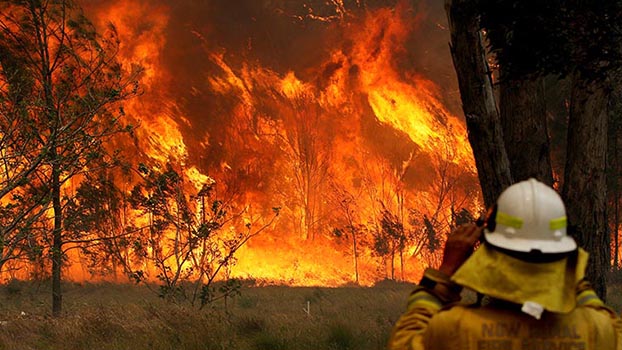Australia bushfires
New South Wales braces for ‘catastrophic’ day

A vast area of Australia’s east coast - including the area around Sydney - is bracing itself for one of the nation’s worst ever bushfire threats.
More than 50 blazes are burning across the state of New South Wales (NSW) ahead of predicted ‘catastrophic’ conditions later on Tuesday, report agencies.
Authorities warn that fires will spread quickly to endanger lives amid hot temperatures and strong winds.
About six million people live in the region.
People in vulnerable communities have been urged to stay away from bushland, and to flee their homes before the fires escalate. More than 600 schools are closed across the state.
State Premier Gladys Berejiklian, who has declared a seven-day state of emergency, said Tuesday would be ‘about protecting life, protecting property and ensuring everybody is safe as possible’.
Three people have died and more than 150 properties have been destroyed since the fire emergency intensified in NSW on Friday.
But authorities say they are now facing what could be ‘the most dangerous bushfire week this nation has ever seen’.
Experts have compared Tuesday’s forecast to the 2009 Black Saturday bushfires in Victoria, when 173 people died.
It’s the first time that a ‘catastrophic’ level fire warning is in place across the greater Sydney area and in the regions to the city’s north and south. The highest level rating was brought in after the 2009 disaster.
‘Under catastrophic conditions, fires that start and take hold will grow and develop extremely quickly and become large fires very, very easily,’ NSW Rural Fire Services Commissioner Shane Fitzsimmons said.
At least 11 emergency warnings had been issued by 15:00 local time (04.00 GMT), warning people their lives were in imminent danger.
But fire chiefs said the worst was yet to come, with forecasts of up to 37C in some areas and possible late changes in wind direction.
Crews are battling a front spanning 1,000km (620 miles) along the north coast of NSW, with several blazes ‘exceeding 100,000 hectares alone’, officials said.
Embers from those bushfires could cause spot fires as far as 30km away, they predicted.
Mr Fitzsimmons said 3,000 firefighters were on the front lines, boosted by crews from other states and New Zealand, as well as the Australian Defence Force.
Prime Minister Scott Morrison said authorities were as prepared as they could be.
Carol Sparks - mayor of Glen Innes, a hard-hit region - said the day would get increasingly ‘volatile and unpredictable’.
‘We’re expecting more tragedies in the area,’ she told the BBC on Tuesday. ‘We’ve had loss of life in our little community just east of Glen Innes, and we’re all devastated by this.’
To the north, Queensland has also declared a state of emergency as more than 50 bushfires rage in the state.
It was not facing as severe weather on Tuesday, but officials warned that conditions could deteriorate later in the week.
Fire crews in South Australia were tacking about a dozen blazes, while bushfires in Western Australia also sparked emergency warnings.
Scientists and experts warn that Australia’s fire season has grown longer and more intense due to climate change.
Officials have confirmed that 2018 and 2017 were Australia’s third and fourth-hottest years on record respectively, and last year the nation experienced its warmest summer on record.
The Bureau of Meteorology’s State of the Climate 2018 report said climate change had led to an increase in extreme heat events and raised the severity of other natural disasters, such as drought.
Even if global temperatures are contained to a 2C rise above pre-industrial levels - a limit set out in the landmark Paris accord, agreed by 188 nations in 2015 - scientists believe the country is facing a dangerous new normal.
Last year, a UN report said Australia was falling short in efforts to cut its CO2 emissions.
BBC



